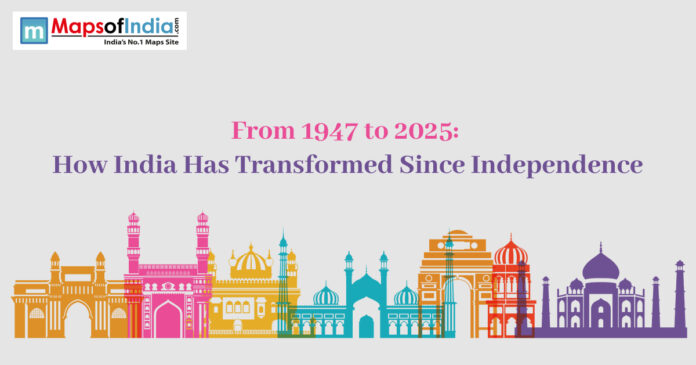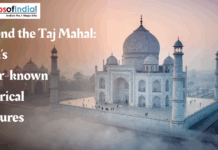It was a wake-up call to life and freedom, and at midnight, August 15 1947, the world was asleep, but not India. The first Prime Minister of the country, Jawaharlal Nehru, eloquently talked about a tryst with destiny, and the path since him has been quite phenomenal. India, born of a new free country which was poor, partitioned and doubtful, has blossomed to become one of the largest economies and vibrant democracies in the world. The 1947 to 2025 transformation is a narrative of strength, reform and the grit to not look back.
The Early Years: A Nation Finding Its Feet
In the year 1947, the economy of India was agrarian, and more than 70 per cent of its population depended on agriculture. It had little industrial infrastructure, appalling illiteracy and a life expectancy of about 32 years. There were the burdens of the scars of the partition, in the form of mass migration, communal violence and displacement.
The short-term endeavour of the government was to build a nation: writing a Constitution, establishing democratic institutions and establishing the economic plan. Adoption of the Constitution in 1950 was the stepping stone to the identity of India as a secular, democratic republic. Based on the socialist ideology, the Five-Year Plans sought to be self-reliant and to have fair growth.
Economic Growth: From a Slow Start to Global Standing
1947–1991: Controlled Growth
During the early years, India was in a mixed economy approach. The industry sector was controlled by its public sector with steel, power, and transport as major industries, whereas agriculture rather had a good policy backing. The Green Revolution was implemented in the 1960s, converted the way food was produced, which made India independent, and was able to prevent famines.
In such a context, unusual forms of licensing policies- commonly known as the License Raj- hampered industrial growth. Although the GDP expanded in a steady fashion, it was well below international standards, and poverty rates were high.
1991–2025: Liberalization and Expansion
In 1991, a balance of payments crisis brought about sweeping economic reforms. India opened up its markets, slackened tariffs and invited foreign investment led by the Prime Minister, P.V. Narasimha Rao and Dr. Manmohan Singh serving as the Finance Minister. This transition was the starting point of India in the world economy.
India is a software hub with the boom in Information Technology in the late 1990s and 2000s. By 2025, India will achieve the status of fifth-largest economy in the world, and it will be very fast in industrial manufacturing, service industries and technology-based industries. New enterprises have thrived, and new domains like renewable energy, e-commerce and fintech are resurgent.
Social Progress: Education, Health, and Equality
Education
In 1947, only 12 per cent were literate. The provision of initiatives such as the Mid-Day Meal Program, Sarva Shiksha Abhiyan, and the Right to Education Act resulted in a drastic change in accessibility. Currently, literacy levels are higher than 77 per cent, and world-class institutions such as the IITs and IIMs are in India. Digital learning sites have also given coverage, particularly to rural settings.
Healthcare
Starting with the fight against epidemics such as cholera and polio, to the fight against modern diseases of the lifestyle, the healthcare system in India has undergone a lot. One historic milestone was in 2014 when polio was eliminated. The government programs such as Ayushman Bharat now cover millions of people with health care insurance, broken through the increased availability of medical advanced technology and telemedicine.
Social Reforms
Enhancements in gender equality, caste equality, and the rights of minorities have emerged as the major steps that have been taken in the past 70 years. Legal reforms such as marriage (child), dowry and discrimination have been resolved. The number of women in politics, business, and science has increased, and they would not go short of feminine role models, such as Indira Gandhi, Kalpana Chawla, and Mary Kom, to name only a few.
Technological Advancements and Digital India
India has made an unprecedented technological breakthrough, witnessing almost zero telecommunication network to an excess of a billion mobile connections by the year 2025.
- Space Exploration: Indian Space Research Organization (ISRO) has met milestones, such as the Mars orbiter mission and Chandrayaan missions, which have developed space technology as a national pride.
- Digital Revolution: Applying the Digital India initiative and the introduction of Aadhaar, Unified Payments Interface (UPI) has revolutionized governance, banking, and service delivery.
- Startup Ecosystem: India is among the largest startup hubs in the world, and by 2025, it will have produced breakthroughs in AI, biotech and clean energy.
Infrastructure and Urban Growth
Roads, railways, airports, and housing are some of the places where one can see the transformation of the cities and villages in India. By 1947, not much connectivity was reached through the road, and most of the nation had to utilize train transportation, which was slow. Expressways, metro systems and high-speed rail developments have transformed mobility nowadays.
Millions have been uplifted by rural electrification, more efficient irrigation systems and housing plans (the latter subsidized). Trade and travel have been enhanced through mega infrastructure projects such as the Golden Quadrilateral and Bharatmala.
Cultural Evolution: Tradition Meets Modernity
Indian culture is rich, regardless of the advent of modernization. Festivals, languages and traditions have kept up to date with contemporary music, cinema and fashion. The Indian movies, consisting of Bollywood along with regional movies, have become global. There has been a reemergence in yoga, Ayurveda and classical arts at the international level.
The internet and social media have also spawned new literary cultural expressions and allowed folk arts and indigenous knowledge to be preserved.
Challenges Along the Way
The move has not been smooth between 1947 to 2025. There is still poverty, unemployment, degradation of the environment and social inequalities. One of the problems that has accompanied rapid urbanization is pollution and overpopulation of the cities. Polarization and regionalization in politics continue to be an uphill climb to inclusive growth.
Nevertheless, the fact that India managed to overcome obstacles despite wars, natural disasters, or the COVID-19 pandemic has shown the power and the solidarity of the country.
India in 2025: A Vision Realized
By 2025, India will be a young, confident and ambitious country. The large population size with more than 65 per cent aged below 35, makes the economy and social developments driven by the energy and creativity of the people. Energy initiatives of renewable energy sources are made to diminish the carbon footprint, and science, education, and healthcare are better than ever before to ensure the convenience of life.
India has increased its influence in the international arena, be it climate change talks, technology advancement, or peacekeeping. The nation has lost its status of being a mere member of international relations, but it has become a decision-maker.
Conclusion: The Road Ahead
The great transformation of the Indian nation through the years, starting with dusty streets of newly independent India in 1947 to the buzzing smart cities of 2025, is a testament to the devotion and wishes of its people. The experience of a journey has been influenced by the sacrifice of freedom fighters, the vision of leaders, and the revival of common citizens.
Given the future, India will be considering the maintenance of an accumulative economic growth, the maintenance of a healthy environment, as well as the fostering of harmony among the diverse Indian society. The Indian narrative is nowhere near done- with the last 78 years only serving to usher in an even greater future.





